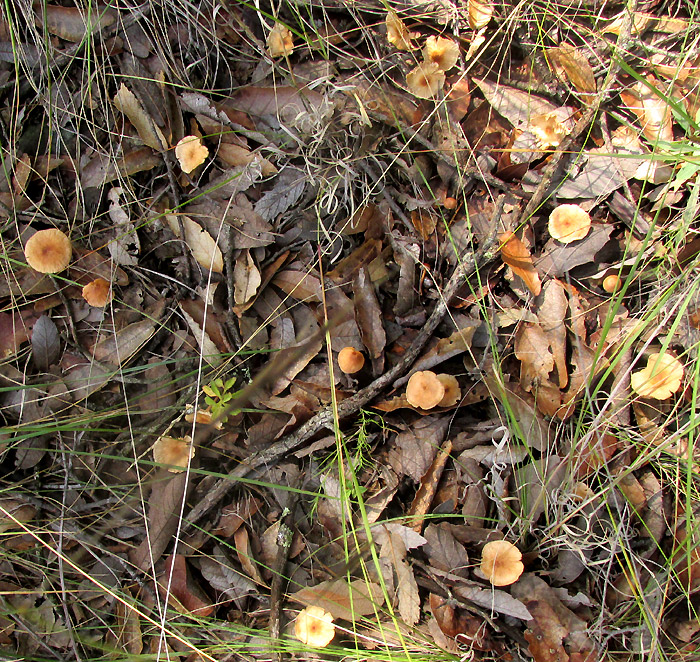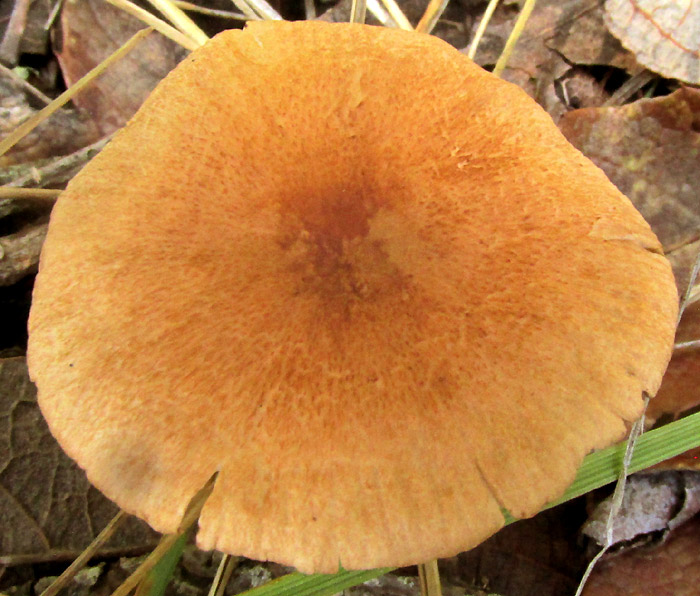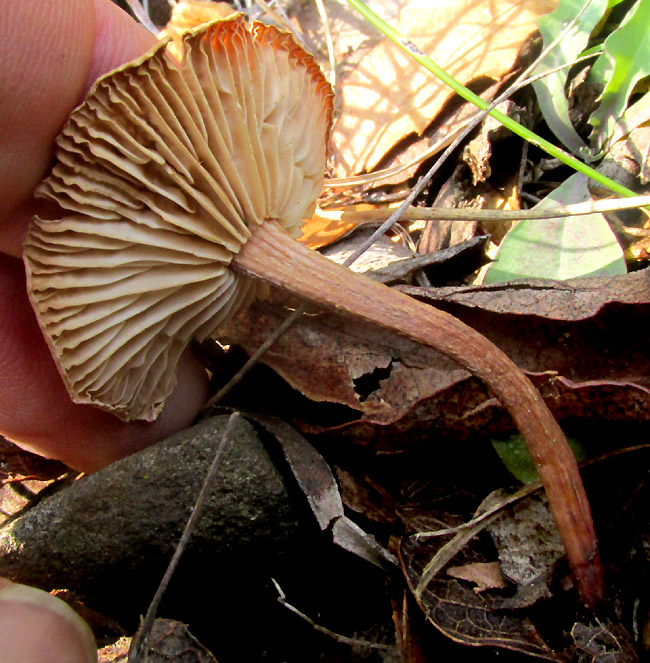Excerpts from Jim Conrad's
Naturalist Newsletter
Entry dated November 10, 2023, from notes taken on ridge with secondary oak forest about 300m west of Cascadas de La Piedad waterfall 3kms NW of the community of San Pablo, municipality of Almeaco de Bonfil; N20.1002°, W100.0067°, elevation 2360 meters (7750ft); extreme southern Querétaro state, MÉXICO
MAYBE CUCUMBER CAPS, TRUE "LBMs"

At the edge of an abandoned field next to a degraded oak woods, the above cluster of LBMs -- little brown mushrooms of which many, many hard-to-distinguish species exist -- were doing well, despite this area experiencing a continuing two-year period the North American Drought Monitor classifies as a D3 Extreme Drought.
Normally I ignore LBMs knowing that, without a microscope, identification would be unlikely. However, these LBMs showed certain distinguishing features that might help. For example: they're drought tolerant and grow in an abandoned field among decomposing grass blades and oak leaves blown from the forest; they live scattered in a diffuse cluster about the size of a large computer screen; they're the only such colony I've seen during two days of wandering the area; the caps are about the size of an Oreo cookie, and; their tops are markedly darker brown in the center than at the much paler edges.

A closer look at the caps shows that it's weakly speckled and blotchy, and the cap is dry and mat, not sticky or shiny. It bears no scales and exhibits no striations radiating from the center.

Above, the gills are of varying lengths, with shorter ones originating at the cap's edge extending toward the center. A narrow notch separates the stem from the gills, and the stem itself bears no ring and doesn't arise from a volva. The slender stem enlarges and is paler toward its top and becomes narrower and darker toward the bottom. The stem is longitudinally shallowly ridged or striated. The cap's edge becomes thin and curls under. The cap smelled faintly the way old mushrooms often do -- something like "musty oily fishy."
At the MushroomExpert.Com website the beginning key for the huge group comprising all North American mushrooms with gills, starts out by separating from all the others a single mushroom species. The identification features described for that species match those seen above. The mushroom is identified as MACROCYSTIDIA CUCUMIS, usually known as the Cucumber Cap, because of the fresh mushrooms' odor. Cucumber Caps were dealt with so early during the identification process not because they're such a distinctive and abundant species, but rather just to be done with the hundreds of LBMs -- little brown mushroom species -- more or less fitting this species' description.
As Michael Kuo, MushroomExpert.Com's expert says of the species, "Aside from the fact that it smells strongly of cucumbers or fish, it has few easily observed features separating it from dozens (even hundreds) of look-alikes -- and it can't even muster up a stable spore print color to help narrow down the possibilities; the color of the print ranges from whitish to pinkish, yellowish, or brownish."
Therefore, we're filing this page under the name Macrocystidia cucumis, recognizing that it may well be something else, especially because the species is overwhelmingly an Eurasian and eastern- and western North American species, as well as appearing in southeastern Australia and New Zealand. I can find no records of it turning up in Mexico or Central or South America. However, spores travel great distances, and we've encountered many species in central Mexico's temperate high elevations, which also are mainly known from northern temperate zones. I do find the genus Macrocystidia documented for our central Mexican highland zone, but the species is not designated. In this region where fungi have been little studied, our mushroom well could be an undescribed species, despite its macroscopic similarity to Macrocystidia cucumis. Our page is for future experts studying "The Macrocystidia cucumis complex."
In much of the Northern Hemisphere, Cucumber Cap mushrooms are regarded as common, and easily recognizable because of their odor. Pictures typically show them inhabiting habitats exactly like ours, scattered among grasses and dropped tree leaves/pine needles. Macrocystidia cucumis is a "soil saprotroph," living in soil and deriving nourishment from decomposing nonliving organic matter such as that provided by dead grass leaves and decaying tree leaves.
I find no literature reporting the use of Macrocystidia cucumis in traditional Mexican medicine. However, the 2021 study by Anna Garber and others entitled "Review of Whole Plant Extracts With Activity Against Herpes Simplex Viruses In Vitro and In Vivo," it was reported that, with regard to antiviral activity against Herpes Simplex virus, Macrocystidia cucumis mycelia grown in a culture broth "... were found to possess antiviral activity, specifically, a decrease in expression of the HSV-1 antigen after 21 days of cultivation."